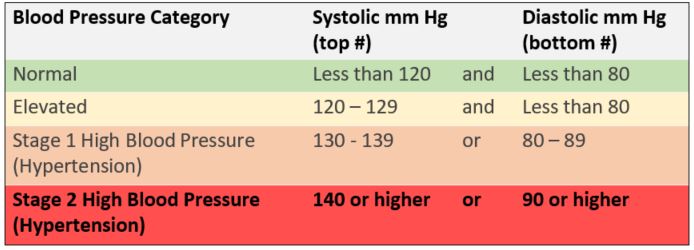According to 2017 hypertension guidelines from the American College of Cardiology and American Heart Association (ACC/AHA), Stage 2 high blood pressure (BP) is defined as 140 mm Hg or higher systolic or 90 mm Hg or higher diastolic.1 The risk for heart attack, stroke and other high blood pressure complications begins to increase around 115/75 mm Hg.1-5 The risk doubles for each 20 mm Hg increase in the systolic pressure and each 10 mm Hg increase in the diastolic pressure.1-5
Diagnosis of hypertension is based on an average of two or more careful blood pressure readings on two or more occasions when the patient is relaxed, sitting for more than five minutes, and has not done anything recently to increase BP such as smoke or exercise.1
Use of BP-lowering medications is recommended for people with Stage 2 hypertension.1 People started on medication should be reassessed in one month. 1
Evidence shows that lowering high BP decreases the risk of adverse cardiovascular outcomes such as heart disease, stroke, and death.6-9 It may also slow the progression of kidney damage in people with chronic kidney disease.10 Further, meta-analyses as well as national and international guidelines suggest that lowering BP decreases risk of these outcomes regardless of which agent is used. 6-9,6
References
- Whelton PK, Carey RM, Aronow WS, et al. 2017 ACC/AHA/AAPA/ABC/ACPM/AGS/APhA/ASH/ASPC/NMA/PCNA Guideline for the Prevention, Detection, Evaluation, and Management of High Blood Pressure in Adults: Executive Summary: A Report of the American College of Cardiology/American Heart Association Task Force on Clinical Practice Guidelines. Hypertension. 2017.
- Lewington S, Clarke R, Qizilbash N, Peto R, Collins R. Age-Specific Relevance of Usual Blood Pressure to Vascular Mortality: A Meta-Analysis of Individual Data for One Million Adults in 61 Prospective Studies. Lancet. 2002;360(9349):1903-1913.
- Rapsomaniki E, Timmis A, George J, et al. Blood Pressure and Incidence of Twelve Cardiovascular Diseases: Lifetime Risks, Healthy Life-Years Lost, and Age-Specific Associations in 1.25 Million People. Lancet. 2014;383(9932):1899-1911.
- Reboussin DM, Allen NB, Griswold ME, et al. Systematic Review for the 2017 ACC/AHA/AAPA/ABC/ACPM/AGS/APhA/ASH/ASPC/NMA/PCNA Guideline for the Prevention, Detection, Evaluation, and Management of High Blood Pressure in Adults: A Report of the American College of Cardiology/American Heart Association Task Force on Clinical Practice Guidelines. Journal of the American College of Cardiology. 2017.
- Wright JT, Jr., Williamson JD, Whelton PK, et al. A Randomized Trial of Intensive Versus Standard Blood-Pressure Control. The New England Journal of Medicine. 2015;373(22):2103-2116.
- Ahluwalia M, Bangalore S. Management of Hypertension in 2017: Targets and Therapies. Curr Opin Cardiol. 2017;32(4):413-421.
- James PA, Oparil S, Carter BL, et al. 2014 Evidence-Based Guideline for the Management of High Blood Pressure in Adults. JAMA. 2014;311(5):507-520.
- Pignone M, Viera AJ. Blood Pressure Treatment Targets in Adults Aged 60 Years or Older. Annals of Internal Medicine. 2017;166(6):445-445.
- Qaseem A, Wilt TJ, Rich R, Humphrey LL, Frost J, Forciea MA. Pharmacologic Treatment of Hypertension in Adults Aged 60 Years or Older to Higher Versus Lower Blood Pressure Targets: A Clinical Practice Guideline from the American College of Physicians and the American Academy of Family Physicians. Annals of Internal Medicine. 2017;166(6):430-430.
- KDIGO 2012 Clinical Practice Guideline for the Evaluation and Management of Chronic Kidney Disease. Kidney International Supplements. 2013;3(1):i-150.


.png)
